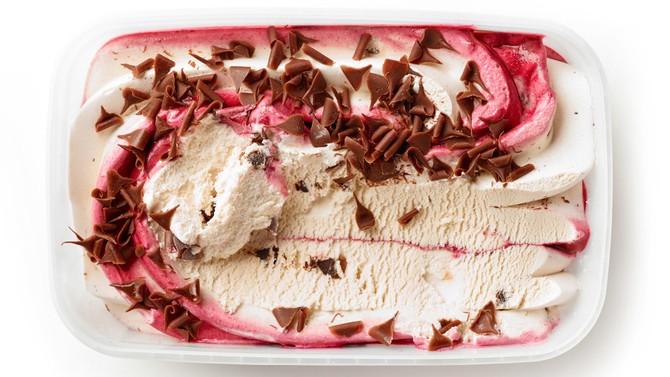You're Scooping Ice Cream Wrong
Are you making any of these mistakes? If so, here's how to fix them, so you can have the best-tasting, best-looking frozen dessert ever.
By Lynn Andriani
The Thaw
Unless you have a separate freezer set to an ideal scooping temp—that would be four to five degrees F—you're probably keeping your ice cream with the rest of your frozen foods, at around zero degrees. That's great for storage, but it's too cold for scooping in most cases (the high butterfat and lack of air in most good-quality ice creams make them very hard at zero degrees). Even if you do manage to extract a scoop, it'll be so cold, you'll hardly be able to taste the flavor, says Michael Palmer, co-owner of McConnell's Fine Ice Creams in California.
So, we know we need to soften the ice cream, but here's where many of us go wrong: We let the pint thaw on the kitchen counter. This results in ice cream that melts around the edges of the container but that stays rock solid in the middle. It's nearly impossible to serve a neat scoop of such varying textures. Instead, advises Shiho Yoshikawa, co-owner/chef at California's Sweet Rose Creamery, transfer the ice cream from the freezer to the refrigerator about 10 to 20 minutes before you want to serve it. Tempering this way will help it warm up evenly. And you'll want to factor in the flavor, as well, says Molly Moon Neitzel, founder and CEO of Molly Moon's Homemade Ice Cream in Seattle: Chocolate will need a head start since it takes longer to thaw than, say, vanilla (which contains alcohol from vanilla extract) or salted caramel (the salt stops the other ingredients from freezing fully).
How do you know it's ready? Bella Loggins, McConnell's director of retail operations, says you should be able to scoop the ice cream "without having to fight it aggressively"—though it shouldn't be as soft as room-temperature butter.
So, we know we need to soften the ice cream, but here's where many of us go wrong: We let the pint thaw on the kitchen counter. This results in ice cream that melts around the edges of the container but that stays rock solid in the middle. It's nearly impossible to serve a neat scoop of such varying textures. Instead, advises Shiho Yoshikawa, co-owner/chef at California's Sweet Rose Creamery, transfer the ice cream from the freezer to the refrigerator about 10 to 20 minutes before you want to serve it. Tempering this way will help it warm up evenly. And you'll want to factor in the flavor, as well, says Molly Moon Neitzel, founder and CEO of Molly Moon's Homemade Ice Cream in Seattle: Chocolate will need a head start since it takes longer to thaw than, say, vanilla (which contains alcohol from vanilla extract) or salted caramel (the salt stops the other ingredients from freezing fully).
How do you know it's ready? Bella Loggins, McConnell's director of retail operations, says you should be able to scoop the ice cream "without having to fight it aggressively"—though it shouldn't be as soft as room-temperature butter.
Published 08/16/2017


